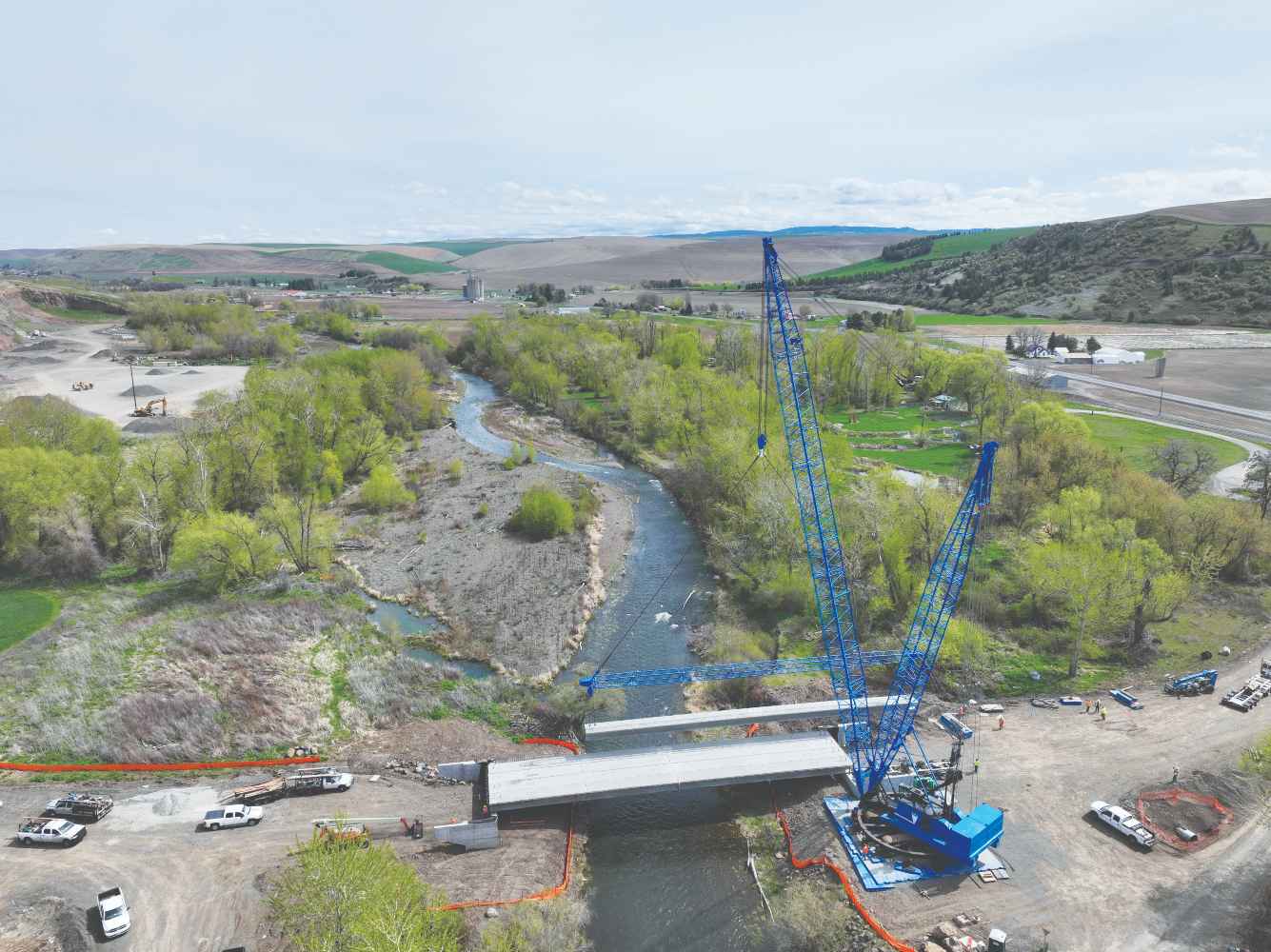Lampson International’s Innovative Bridge Girder Lift Solution
Over the River: How Lampson International Engineered a Seamless Bridge Replacement
When you have more than 70 years of experience in the heavy lifting industry, it should come as no surprise to be called on to handle projects requiring innovative solutions, specialized equipment and expertise in planning and execution. Last year, that was exactly the case when Lampson International was contacted about a bridge girder replacement project.
“Originally, the contractor and concrete girder supplier had another crane company set up for the job,” said Tim DeBord, superintendent at Lampson who oversaw the project. “However, they had to back out because they had planned to put cranes on each side of the river, but the old bridge was condemned and couldn’t be used to move the crane across. That’s when they contacted us to see if we had a solution.”
In April 2024, Lampson partnered with Pacific Northwest construction contractor Goodman Mehlenbacher Enterprises (GAME) Inc. and American Rock Products, the producer of concrete products, for the replacement of the single-span Vernon Smith Bridge over the Touchet River in Dayton, Washington. The combined state and Columbia County project called for lifting and placing five 135-foot precast girders, each weighing more than 200,000 pounds with rigging.
Initially contacted by GAME, DeBord and Lampson’s equipment manager, Rusty Rutherford, began the planning process for a viable crane option.
Unique Aspects
“We needed to develop a single crane lift plan to minimize risk and exposure both for the lift and utilization of the condemned bridge,” DeBord said. “That included some unique aspects for this job, such as needing to stay 50 feet back from the new abutment and the proximity to the rushing water and still be able to place the girders at a 120-foot radius from a stationary location.”
Lampson’s solution was to deploy their Manitowoc 4100 lattice boom crawler crane with 200 feet of boom length on a temporary ringer on the south bank of the river to perform the lifts. The Manitowoc 4100 SIII ringer was selected for its ability to smoothly handle heavy loads at a variety of radii.
“Adding a ringer to the crane distributed the load over a large area,” DeBord explained. “It’s essentially an extension of a conventional crane that can also hold 275,000 pounds of auxiliary counterweight to increase lifting capacity. The counterweight moves in sync with the crane around the ring to balance the load that’s opposite from the boom.”

Stable Base
For the Vernon Smith Bridge project, Lampson crews assembled the superstructure of the 36-foot diameter ring and the Manitowoc crawler on steel mats spread over a 90-by-50-foot area. “The lift plan needed to account for ground stability,” DeBord related. “On construction sites like this one, after piers for the new bridge are in place, soil is backfilled so settling can occur. That makes having a stable base for the crane a big concern.
“Our solution was to spread steel mats that don’t flex over the area where the crane and ringer would sit to create a stable base,” DeBord explained further. “If we had set the ring on bare ground or used smaller mats, the ground below would have settled, creating instability.”
The calculations used to determine the need for steel mats and the area of coverage are part of the lifting plan, DeBord noted. Factors used by engineering experts included ground conditions and ground bearing capabilities, boom length and lift radius, counterweight and the weight of the rigging and precast girders.
“It all comes down to how much weight you’re putting on the ground per 1,000 square feet,” DeBord said. “Everything has to be in line with the ground bearing that is determined.”
Specialized Rigging
The Lampson Manitowoc 4100 was also fitted with a 130-foot spreader bar for the 135-foot precast bridge girder lifts. The spreader bar, which is usually used on jibs, according to DeBord, was equipped with specialized ends designed to allow for picks with only half a degree of tilt.
“Not only does a nearly vertical lift keep the weight close to the weight of the girder and eliminate the need for shivs to run wire over,” DeBord added. “It also allows for connections at pick points that will not cause any damage to the precast bridge girders from hooks or chains.”
On the jobsite, Lampson crews first laid out the steel mat base and then assembled the crane and ringer using Grove GMK 5250 all-terrain and 60-ton Grove rough terrain cranes to lift heavy parts and ancillary gear into place. The assembly process took about 50 hours.
Also integral to a smooth and successful project on the Vernon Smith Bridge was Lampson’s maintenance team. Before the Manitowoc crawler even left for the job, it was thoroughly inspected and readied for service.
“Our Manitowoc factory-trained technicians can tackle anything,” DeBord said. “On the jobsite, our director overseeing the assembly and disassembly process is also a qualified technician, and our crane operators are capable of taking care of any small issues that may arise.”
Start to Finish
On-site start to finish over a month-long period, the Lampson crews operated the Manitowoc crawler and directed the crane’s operator to put the precast girders in place. The actual setting of the beams took just one day.
In the end, the $2.7 million Vernon Smith Bridge replacement project was completed on time, in accordance with GAME and American Rock Products schedules, and most importantly, DeBord noted, with zero safety incidents.
Based in Kennewick, Washington, Lampson International fields a fleet of over 350 lattice boom, telescopic boom crawler, rough terrain, all-terrain and truck cranes for use by construction contractors under taxi crane and bare lease agreements.



